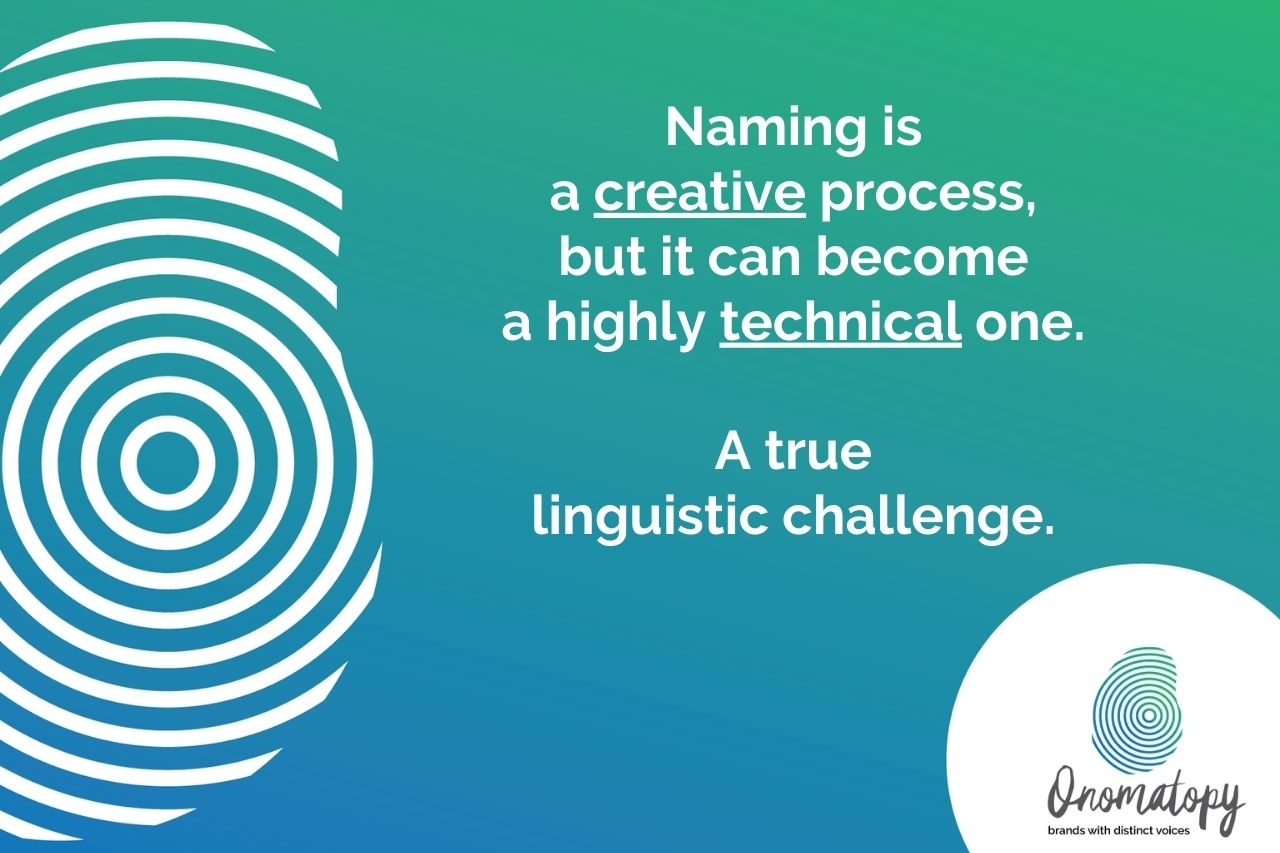Brand naming plays a crucial role in the success of a business. It serves as the foundation on which brand identity is built and determines how the brand is perceived in the market. To create an effective brand name, a systematic approach is essential. This article will guide you through our naming process here at Onomatopy, including the importance of a naming brief.
- RESEARCH:
Before diving into the naming process, it is mandatory to conduct a thorough research. This involves studying the target audience, competitors, market trends, and any existing names that may create confusion or conflict. By understanding the landscape, we can identify opportunities and avoid pitfalls.
- NAMING BRIEF:
A naming brief needs genuine insights whether you work with an agency, freelancer or naming or branding studio like us. It’s a tool that outlines the brand concept and naming objectives and provides a roadmap for the naming process, ensuring that the name aligns with your goals.
This is usually something we work together on with clients in a dedicated discovery workshop. Key components of a naming brief include:
a. Concept statement: a concise statement that describes the unique positioning of your brand – if it’s an already established brand. If you are creating a new brand, this is something you can work on with the naming specialists.
b. Overview: background information about the company, including its history, location, key people and core activities.
c. Market: the target audience in detail, including their demographics, psychographics, preferences, and behaviours. This helps tailor the name to resonate with your specific customer base.
d. Competitors, vendors, and partners: competitors’ names, naming trends on your specific market and any potential conflicts or confusion they may cause. We evaluate the strengths and weaknesses of competitors’ names to inform the naming strategy.
e. Naming history: If we’re rebranding or renaming a product, finding out about any previous names that have been considered helps avoid repetition and provides insights into past naming decisions.
f. Brand personality: the personality traits and attributes you want your brand name to convey. Consider adjectives that capture the desired brand image, ensuring they align with your target audience’s expectations.
g. Naming objectives: specific objectives or messages that the name should communicate. Successful names typically focus on one key message or trigger of curiosity.
h. Specific criteria: requirements and preferences for the name. This may include things like linguistic simplicity, use of alliteration or the use of specific languages or word types.
i. Make it personal: we dig for any relevant associations, personal preferences and anecdotes that could contribute to the naming process. These can serve as creative sparks and provide additional context for the development of the brand name.

- NAMING PHASES:
Once we have a comprehensive naming brief in place, the naming process can be divided into phases. These phases typically include:
a. Ideation: We generate a broad range of potential names, taking into account the criteria and objectives outlined in the naming brief. We encourage creativity and explore various linguistic and conceptual directions.
b. Evaluation: We review and evaluate the generated names against the distinctiveness, sound, positioning, energy, humanity, and memorability factors. We carefully discuss and consider feedback from stakeholders, conduct trademark searches, assess domain name availability and social/digital availability.
c. Refinement: We refine the shortlisted names based on feedback and further analysis. Ensure that the selected name aligns with the brand’s positioning, resonates with the target audience, and meets the naming objectives.
d. Validation: We test the potential name(s) with focus groups or target consumers to gauge their reactions and associations. This feedback can provide valuable insights and help refine the name if necessary.
e. Selection: Choose the final brand name that best aligns with all the criteria and objectives outlined in the naming brief. Ensure that the name has a positive emotional impact, is memorable, and reflects the brand’s essence.
- NAMING CRITERIA
To create an effective brand name, there are several factors we always consider to craft a powerful and impactful brand name:
- Distinctiveness
Distinctiveness refers to the originality and strength of a brand name in comparison to its competitors. A distinctive name sets a brand apart from the crowd, making it memorable and instantly recognizable. To enhance distinctiveness, consider:
- Avoiding generic terms or commonly used words.
- Employing unique word combinations, neologisms, or creating new words.
- Incorporating visual elements, symbols, or icons that accompany the name.
- Sound
The auditory appeal of a brand name greatly influences its memorability and likability. Factors to consider for a name’s sound quality include:
- Pronounceability: Choose a name that is easy to pronounce and avoids complex or confusing phonetic combinations.
- Alliteration, rhyme, and rhythm: Utilize these techniques to create a catchy and melodic name that rolls off the tongue.
- Repetition: Repetitive sounds or syllables can enhance memorability and create a memorable brand name.
- Linguistic flexibility and “verbability”: Consider whether the name can be transformed into a verb or action term, like “Google” or “Tweet,” which facilitates brand integration into everyday language.
- Positioning
The positioning of a brand name aligns it with the industry, business category, or product it represents. Consider the following factors when evaluating the positioning of a brand name:
- Relevance: Ensure that the name reflects the nature of the business and resonates with the target audience.
- Consistency: The name should align with the company’s personality, values, and long-term goals.
- Differentiation: The name should set the brand apart from competitors and create a unique positioning in the market.
- If it’s a name that cannot position the brand in the category, then the tagline substitutes this need.
- Energy
The energy of a brand name refers to its ability to capture attention, generate interest, and evoke curiosity among consumers. Consider the following strategies to infuse energy into a brand name:
- Evocative language: We choose words that elicit emotions, create intrigue, and stimulate curiosity.
- Bold and impactful: We opt for a name that conveys a strong message, leaving a lasting impression on the audience.
- Humanity
A brand name’s humanity encompasses its capacity to evoke emotions, tell a story, and create a connection with consumers. Consider the following elements to infuse humanity into a brand name:
- Emotional resonance: Select a name that elicits positive emotions or resonates with the target audience’s aspirations, values, or desires.
- Storytelling: Craft a name that can be associated with a narrative, capturing the essence of the brand’s purpose or heritage.
- AI tools like ChatGPT are great as a research tools but they lack deep insight and originality, a dimension that makes names unforgettable.
- Memorability
A memorable brand name is crucial for creating lasting impressions and facilitating brand recall. Consider the following techniques to enhance memorability:
- Simplicity: Choose a name that is concise, easy to remember, and avoids complex or convoluted terms.
- Familiar associations: Incorporate familiar words or concepts that resonate with the target audience, enabling quick recognition and recall.
- Ownability
The ownability of a brand name ensures its exclusivity and legal protection. We pre-test the following factors when assessing the ownability of a name:
- Trademark availability: Conduct a thorough search to ensure the name is not already trademarked or in use by another company in a similar industry and for the targeted markets.
- Domain name availability, the importance of a simple .com and social media channels availability for the chosen name.
Creating a powerful brand name requires a systematic approach and a clear understanding of your brand concept, objectives, and target audience. By conducting thorough research, developing a comprehensive naming brief, and following the naming phases, you can craft a name that resonates with consumers, sets your brand apart, and drives success in the market.
At Onomatopy, we create names for the global market which will help your company stand out, grow strong and resonate with customers across variuos cultures.
Written by Alina Chirvase, Senior Brand Strategist at Onomatopy. Get in touch.

